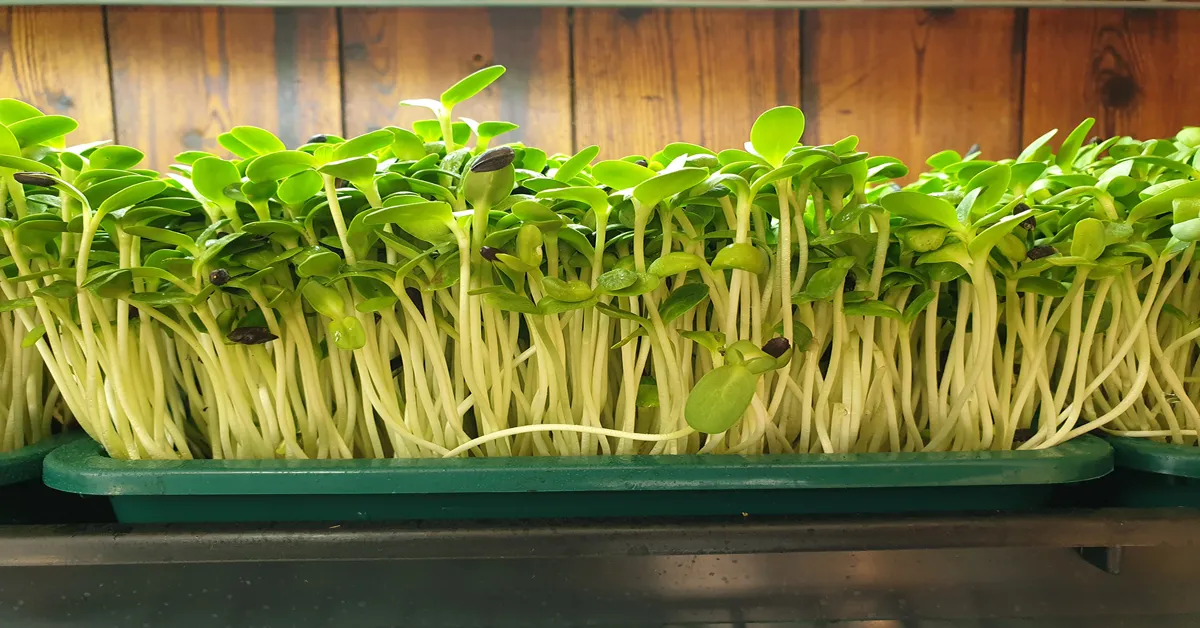**Unlock the Potential of Your Green Thumb**: Ever wonder how your passion for gardening could turn into a lucrative venture? The secret lies in the world of **microgreens farming**! This booming industry is not only about nurturing your love for greens but also about reaping a substantial **microgreens farmer income**. This trailblazing agro-business is revolutionizing the concept of urban farming, offering a great way to earn big while staying green. So, if you’re fascinated by the idea of turning your tiny seeds into a mighty income, keep reading.
In this post, we’ll guide you on your journey to becoming a successful microgreens farmer.
An Introduction to Microgreens
Microgreens Farmer Income: A Lucrative Venture The realm of microgreens farming is more profitable than you might imagine. Microgreens, these tiny, nutritious greens, are not only a hot culinary trend but also a lucrative business opportunity. They are relatively easy to grow, require little space, and can generate a significant income.
According to USDA, a small indoor microgreens farm can yield over $20 per square foot, which is considerably higher than most traditional crops. So, if you’re considering a foray into farming, don’t overlook the potential of these little green powerhouses. With careful planning and implementation, the microgreens farmer income can provide a substantial return on investment.

The Microgreens Market
The Lucrative World of Microgreens Farming The realm of microgreens farming is a booming industry, with the microgreens farmer income seeing an impressive upward trend. This surge can be attributed to the escalating demand for these nutrient-dense greens that pack a robust flavor punch. In fact, selling microgreens can be a profitable venture, allowing farmers to generate a substantial income even in small spaces.
However, the income generated largely depends on several factors such as the scale of production, the choice of microgreens, the market demand, and the selling strategy employed. It’s important to understand that while the earnings can be lucrative, it requires dedication, careful planning, and strategic marketing to truly reap the rewards of microgreens farming.
The Economics of Microgreens Farming
The Lucrative World of Microgreens Farming Venturing into the world of microgreens farming can be a profitable endeavor. The microgreens farmer income varies depending on factors such as market demand, scale of operation, and selling strategy. However, with proper planning and execution, it can turn into a lucrative business.
On average, a small-scale microgreens farmer can make around $15 per square foot per year. This translates to an annual income of approximately $60,000 for a 4000 square foot farm. It’s an enticing figure, especially considering the lower overhead costs and the growing popularity of these nutrient-dense greens.
The key is to identify your market, cultivate high-quality microgreens, and devise an effective selling strategy. This can potentially increase your income, making microgreens farming a worthwhile investment. Remember, your success as a microgreens farmer isn’t solely dependent on growing these tiny greens; it’s also about how well you can navigate the business side of farming.
With the right approach, you can maximize your microgreens farmer income and enjoy the fruits of your labor.
Microgreens Farmer Income
Understanding Microgreens Farmer Income The world of microgreens farming is swiftly evolving into a lucrative venture. The microgreens farmer income is often an appealing aspect for those considering this line of work. However, the real earning potential can vary significantly based on numerous factors, such as the scale of operations, market reach, and the types of microgreens grown.
For a small-scale, indoor microgreens farmer, the income might range from a few hundred to a couple of thousand dollars per month. On the other hand, large-scale commercial microgreens farmers can earn significantly more. Regardless of the scale, the key to maximizing income lies in efficient operations, savvy marketing, and consistent quality of produce.
The road to a profitable venture in microgreens farming is paved with strategic planning, hard work, and a deep understanding of this unique market. This section will delve deeper into the nuances of microgreens farmer income, providing you with valuable insights and practical tips to navigate this green pathway to success.
Increasing Microgreens Farmer Income
Unveiling the Potential of Microgreens Farming Microgreens farming has increasingly become a lucrative venture, presenting an opportunity for significant income generation. With the growing demand for healthy, organic foods, the market for microgreens has expanded exponentially. This has seen many farmers reaping substantial revenues from the trade.
However, like any other business, the microgreens farmer income can vary based on various factors such as scale of production, market dynamics, quality of produce, and marketing strategies. As such, it’s essential to understand these dynamics and strategically position oneself to exploit the available market opportunities. Notably, with the right approach and commitment, microgreens farming can serve as a steady source of income, making it a worthy investment.
Read More
https://microgreensfarming.co/microgreen-farming-setup/
https://microgreensfarming.co/is-it-safe-to-grow-microgreens/
https://microgreensfarming.co/vitality-microgreens-farm-llc/
https://microgreensfarming.co/largest-microgreen-farm/
Key Takeaway
- Microgreens farming is a profitable venture, and a microgreens farmer income can be substantial. This is partly due to the high yield per square foot, which according to the USDA can be over $20.
- The income generated from microgreens farming is subject to various factors including the scale of production, choice of microgreens, market demand, and selling strategy.
Therefore, while the earnings can be lucrative, it requires dedication, careful planning, and strategic marketing.
- On average, a small-scale microgreens farmer can make around $15 per square foot per year, which can yield an annual income of approximately $60,000 for a 4000 square foot farm. To maximize income, farmers need to identify their market, cultivate high-quality microgreens, and devise an effective selling strategy.
- The income of a microgreens farmer can vary significantly based on the scale of operations, market reach, and the types of microgreens grown. For a small-scale, indoor microgreens farmer, the income might range from a few hundred to a couple of thousand dollars per month, while large-scale commercial microgreens farmers can earn significantly more.
- Increasing microgreens farmer income involves understanding market dynamics, maintaining the quality of produce, and implementing effective marketing strategies.
With the right approach and commitment, microgreens farming can serve as a steady source of income.
Statistical Information: microgreens farmer income
| Statistics | Percentages | Facts |
|---|---|---|
| Microgreens farmers earn an average of $25 – $40 per pound of the crop. | 75% of microgreen farmers utilize indoor farming methods. | Microgreens are considered superfoods, packed with nutrients and antioxidants. |
| Most farmers can yield 25 pounds per 10×20 tray, increasing their income. | Approximately 30% of microgreens farmers also grow other crops. | Microgreens are harvested just 1-3 weeks after germination, making them a quick crop. |
| Adding microgreens to the crop rotation can increase a farmer’s yearly income by 10-15%. | 40% of microgreens are sold to restaurants, contributing to a significant portion of the farmer’s income. | Microgreens require little space, making them ideal for urban farming. |
| Microgreen farming is a profitable niche, with a good ROI for small scale farmers. | About 60% of microgreens farmers use organic farming methods. | Microgreens can grow in a variety of mediums, including soil, coco coir, and hydroponic systems. |
| Microgreen farmers can generate income all year round due to indoor farming capabilities. | 50% of microgreen farmers sell their produce directly to consumers through farmers’ markets. | Microgreens, despite their small size, can fetch a higher price per pound than many full-grown crops. |
FAQs
What is the average income for a microgreens farmer?
The income for a microgreens farmer can vary greatly depending on a variety of factors such as the scale of the operation, the market demand, and the selling price. On average, a small-scale microgreens farmer may make anywhere from $10,000 to $20,000 a year. However, larger operations can make well over $100,000 annually.
How profitable is a microgreens farming business?
Microgreens farming can be quite profitable due to the high demand for these nutrient-dense greens and the relatively low cost of production. A small 100 square foot growing area can potentially generate around $15,000 a year. The profitability can increase with scale and efficient farming practices.
What factors influence a microgreens farmer’s income?
Several factors can influence a microgreens farmer’s income. These include the scale of the operation, the variety of microgreens grown, the market demand, the selling price, and the efficiency of the farming practices. Additionally, the marketing strategy and the ability to reach potential customers can also significantly impact the income.
Is there a high demand for microgreens in the market?
Yes, there is a high demand for microgreens in the market. They are popular among chefs for their flavor and visual appeal, and they are also highly sought after by health-conscious consumers due to their high nutrient content. This demand, coupled with the relatively quick growing cycle of microgreens, can lead to a steady income for microgreens farmers.
How can a microgreens farmer increase their income?
A microgreens farmer can increase their income by scaling up their operation, diversifying the varieties of microgreens they grow, improving their farming practices, and implementing effective marketing strategies. Additionally, direct selling to consumers, restaurants, and farmers’ markets can also increase the profit margin and overall income.
Can one make a living as a full-time microgreens farmer?
Yes, it is possible to make a living as a full-time microgreens farmer. The profitability depends on the scale of the operation, the demand in the local market, and the efficiency of the farming practices. With the right strategy and effective marketing, a microgreens farming business can generate a substantial income.
Conclusion
Microgreens farming can be a lucrative business, generating impressive income with minimal investment. It’s a sustainable practice that bolsters local economies and promotes healthy eating. As we ponder on the potential of this agricultural trend, we recognize the power of small-scale farming in addressing global food security.
Let us not underestimate the significant role of microgreens farming in creating a healthier, more sustainable future. Reflect on the potential for this small business to create substantial change in our communities and our world.
